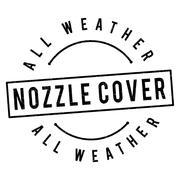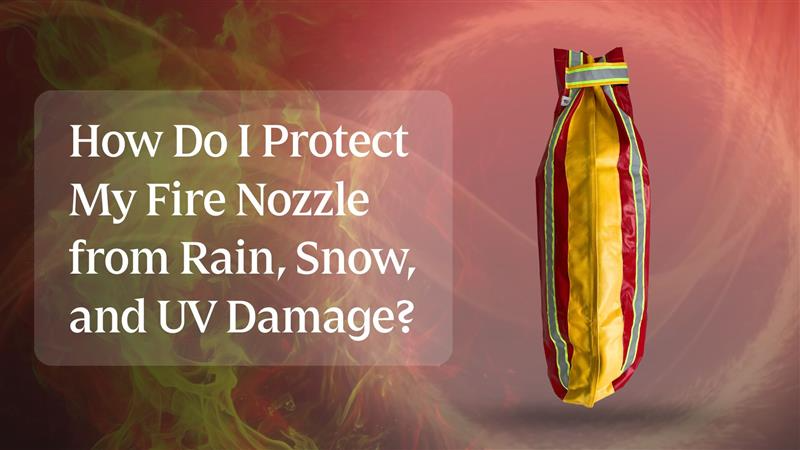Introduction: The Importance of Fire Nozzle Protection
Firefighting is a job where every second and every tool matter. Your fire nozzle and portable monitor are some of the most important pieces of equipment you have. But what happens when they are left outside, exposed to rain, snow, and the hot sun? Over time, even the toughest fire nozzles can get damaged by the weather.Protecting your fire nozzle from rain, snow, and UV damage is not just about keeping it looking good. It’s about making sure it works perfectly when you need it most.
Imagine a fire crew getting a call in the middle of a storm. They rush to their truck, grab their portable monitor, and find that the nozzle is stuck or rusty. That delay can make a big difference in an emergency. This is why so many fire departments are asking: “How do I keep my fire nozzle safe from the weather?”
Choosing the Right Cover for Your Equipment
Every department is different, and not every cover fits every nozzle. That’s why it’s important to pick a cover made for your specific monitor. If you use an Akron Quick Attack, you’ll want a cover designed for that model, like the Akron Quick Attack Cover. If your team uses a Blitzforce monitor, there’s a Blitzforce Cover made just for that. When choosing a cover, check the fit, the materials, and the warranty. Make sure it’s approved by trusted manufacturers and has good reviews from other fire departments.
A Real Story: Weather Challenges at the Fire Station
Let’s picture a fire station in a place where the weather changes all the time. Sometimes it’s raining, sometimes it’s snowing, and sometimes the sun is so hot it feels like it could melt metal. The crew uses their portable monitors for all kinds of calls. After a tough winter, they notice that the nozzles are getting rusty and dirty. It takes longer to clean them, and they worry about the equipment failing during a fire.
The solution comes when the crew tries a rugged, weatherproof nozzle cover. Suddenly, the nozzles stay clean and dry. The team spends less time on cleaning and more time on training. Over the next year, the difference is clear: less rust, fewer repairs, and more confidence that their gear will work every single time.
What Damages Fire Nozzles?
Fire nozzles are built to be strong. But when they are left outside, they face some tough challenges:
• Rain and Moisture: Water can get into small cracks and joints, causing rust and corrosion. Over time, this can make the metal weak and cause parts to stick or break.
• Snow and Ice: When water freezes, it expands. If water gets inside the nozzle and then freezes, it can crack the metal. Salt from winter roads can make rust happen even faster.
• UV Rays from the Sun: The sun can break down rubber seals and fade plastic parts. UV damage is not always easy to see, but it can make your nozzle wear out much faster.
• Dirt, Mud, and Debris: When your nozzle is stored outside, it can get covered in dirt and mud. This can clog moving parts and make cleaning a big job.
Why Is Nozzle Protection So Important?
When your nozzle is damaged, it can slow you down in an emergency. Rust can make parts stick. Dirt and mud can clog the nozzle. UV rays can make seals crack and leak. All of these problems mean more time spent on cleaning and repairs, and less time ready to respond to a call.
A good cover can stop these problems before they start. It keeps your nozzle safe from the weather, so it’s always ready when you need it.

So, how do you protect your fire nozzle from rain, snow, and UV rays? The answer is simple: use a weatherproof cover made just for your equipment. These covers are designed to keep out water, snow, dirt, and the sun’s rays. They are made from tough materials and fit snugly over your nozzle and monitor.
For example, the fire equipment covers, like, Standard BlitzFire™ Firefighting Nozzle Cover, are built to fit right behind the mounting bracket and are strong enough to handle any weather. It has a full front zipper for quick access and lets you keep your monitor pre-connected to the hose.
What Makes a Good Fire Nozzle Cover?
Not all covers are the same. How should you choose the ideal nozzle cover?The best covers have a few important features:
• Strong Materials: Look for covers made from heavy-duty, weather-resistant fabric. They should be able to handle rain, snow, sun, and salt.
• Custom Fit: A cover that fits your nozzle perfectly will protect it better and stay in place during transport.
• Easy to Use: You should be able to take off the cover quickly in an emergency. Zippers or quick-release straps are a big help.
• Long Warranty: The best covers come with a long warranty, like five years or more. This shows that the company stands behind its product.
How Do Nozzle Covers Work in Real Life?
Let’s go back to that fire station. After switching to weatherproof covers, the crew sees a big difference:
•The nozzles stay cleaner, even after driving through mud or snow.
• There is less rust and corrosion, even when the roads are salty in winter.
• The team spends less time cleaning and more time training or answering calls.
• The equipment lasts longer, which saves the department money on repairs and replacements.
Frequently Asked Questions About Fire Nozzle Protection
Why do I need a weatherproof cover for my fire nozzle?
A weatherproof cover keeps your nozzle safe from rain, snow, UV rays, and dirt. This helps prevent rust, corrosion, and damage, making sure your equipment works when you need it.
Can I leave my fire monitor connected to the hose with the cover on?
Many covers, like the Standard BlitzFire™ Firefighting Nozzle Cover, are designed to let you keep your monitor pre-connected to the hose while still being protected.
How long will a good nozzle cover last?
A quality cover made from strong materials can last for years. Some, like those from All Weather Nozzle Cover, come with a five-year warranty.
Will a cover slow me down in an emergency?
No. The best covers have quick-release zippers or fasteners, so you can remove them fast and get to work right away.
How do I clean and maintain my nozzle cover?
Most covers can be wiped down with soap and water. Check for any rips or damage during regular equipment checks and replace the cover if it’s worn out.
Are these covers approved by equipment manufacturers?
Some covers are officially approved by leading manufacturers, which means they’re tested for fit and durability.
Can a cover protect my nozzle from freezing?
While a cover helps keep out snow and ice, it won’t stop water inside the nozzle from freezing. Always drain your equipment in cold weather.
What if my cover gets damaged?
If your cover is under warranty, you can usually get a replacement. For example, All Weather Nozzle Cover offers a full five-year warranty on their products.
Maintenance Tips: Keeping Your Nozzle and Cover in Top Shape

Protecting your nozzle is about more than just using a cover. Here are some easy ways to keep your gear ready:
• Inspect Regularly: Check your nozzle and cover for signs of damage, rust, or wear. Fix problems right away to avoid bigger issues.
• Clean After Use: Wipe down your nozzle and cover after every call, especially if you’ve been through mud, snow, or salt.
• Store Properly: When not in use, keep your nozzle covered and out of direct sunlight. This helps prevent UV damage and keeps it clean.
• Replace When Needed: If the cover is torn or worn out, replace it. Don’t wait until your equipment is at risk.
The Science Behind Weather Damage
Rain and snow bring moisture that can seep into tiny cracks and joints, leading to rust. Salt from winter roads speeds up this process, eating away at metal parts. UV rays from the sun break down rubber seals and fade plastic, making them brittle over time. Even dirt and mud can cause trouble, clogging moving parts and making cleaning a constant job.
A good cover acts like a shield, blocking out these threats and keeping your nozzle in top shape.
What Happens If You Don’t Protect Your Nozzle?
Leaving your nozzle exposed can lead to:
• Rust and Corrosion: Moisture causes metal to rust, which can make parts stick or break.
• Stuck Valves or Fittings: Dirt and grime build up, making it hard to use the nozzle in an emergency.
• Cracked Seals: UV rays and freezing temperatures break down rubber, leading to leaks.
• Higher Maintenance Costs: More cleaning and repairs mean more time and money spent on equipment.
Real Results: Departments That Made the Switch
Departments that switch to weatherproof covers often see big improvements. Nozzles last longer, cleaning takes less time, and there are fewer equipment failures. Crews feel more confident knowing their gear will work, no matter the weather.
How to Pick the Best Cover for Your Needs
When shopping for a nozzle cover, consider:
• Fit: Make sure the cover is made for your specific nozzle or monitor.
• Material: Look for heavy-duty, weather-resistant fabric that stands up to sun, rain, and snow.
• Ease of Use: Choose a cover with quick-release zippers or fasteners for easy access.
• Warranty: A long warranty shows the manufacturer stands behind their product.
• Approval: Check if the cover is approved by the equipment manufacturers.
Common Myths About Fire Nozzle Protection

Myth 1: “My nozzle is built tough. It doesn’t need a cover.”
Even the best equipment can break down if left in harsh weather. A cover adds an extra layer of protection that saves money and time.
Myth 2: “Covers are hard to use and slow me down.”
Modern covers are designed for quick removal, so you can get to your nozzle fast in an emergency.
Myth 3: “Covers only protect from rain.”
A good cover shields your nozzle from snow, salt, UV rays, and dirt-not just rain.
Final Thoughts: Protect Your Nozzle, Protect Your Team
Your fire nozzle is a lifeline in an emergency. Protecting it from rain, snow, and UV damage is one of the simplest ways to make sure it works when you need it. With a weatherproof cover, regular checks, and smart storage, you’ll keep your equipment ready for action-no matter what the weather brings.
If you want to learn more about keeping your fire equipment safe, firefighter equipment store the All Weather Nozzle Cover website. You’ll find covers for every major portable monitor, plus tips and resources for erosion protection for fire departments of all sizes.
Every fire call is different, but one thing never changes: your equipment must be ready. By protecting your fire nozzle from the elements, you’re taking a simple step that makes a big difference for your team and your community.

